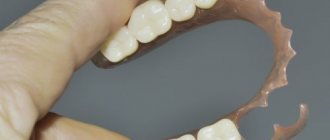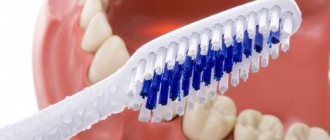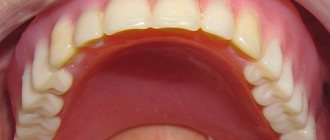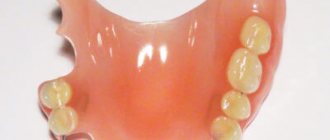Attachments are small fastenings used in removable and fixed prosthetics. With the help of attachments, the prosthesis is securely attached to the implants or supporting teeth. Thanks to the reliability of the fixation, a person does not experience discomfort while chewing food and talking. The main advantage of the attachment system is aesthetics and reliability.
What is a clasp prosthesis with attachments?
Arc prosthesis (“clasp”, translated from German as an arc)
consisting of a metal frame with a mask base that completely imitates gums and attached artificial teeth is called clasp. A distinctive feature is the method of fastening. If you imagine a push-button mechanism known to everyone, the principle will become clear. One locking part is located on the removable denture itself, and the second is on the crowns that are placed on the supporting teeth. The lock snaps into place and the clasp is firmly fixed in the oral cavity.
Bottom line
Strong fixation, ease of use, ease of cleaning and lack of discomfort during communication - all types of attachments have been highly appreciated by patients in dental clinics. Despite the high price, the attachment system pays for itself due to its long service life and inexpensive maintenance.
Hook-mounted dentures are becoming a thing of the past. The attachment system is more advanced and convenient. The range of lock fastenings includes more than one hundred items. Each type differs from the other in a special way of fastening, size and functionality. The price range for a prosthesis with an integrated attachment system ranges from 100 to 1200 conventional units. The price includes the price for diagnosis, installation, the orthodontic product itself and the lock for it.
Sources used:
- “Removable dentures: a textbook” (Mironova M.L.)
- Murray JJ (Nov 2011). “Adult dental health surveys: 40 years on.”
- Artun J, Smale I, Behbehani F, Doppel D, Van't Hof M, Kuijpers-Jagtman AM (2005).
Stages of prosthetics
- sanitation of the oral cavity, assessment of teeth that will serve as supports. If you need to install implants under crowns, then implantation;
- turning supporting units, taking impressions from them;
- production of crowns with males;
- taking an impression, making a frame, trying it on, making a prosthesis with artificial crowns;
- fitting of a finished clasp prosthesis with locks, correction;
- installation of crowns on cement, snapping of attachments.
Indications for the use of clasp structures
- 2-sided end defects (there are no distally located teeth that can be used as supporting ones).
- Unilateral end defects.
- Absence of more than 3 lateral teeth in a row (a permanent bridge cannot be used).
- Absence of more than 4 frontal teeth in a row (for the same reason as stated above).
- Multiple missing teeth.
- Adentia in combination with periodontitis.
Caring for your prosthesis
For a long service life of an orthopedic product, it must be cleaned of food debris and plaque on the crowns. At the same time, as usual, brush your teeth and denture parts 2 times a day, rinse your mouth after eating. Use a special antiseptic solution for dentures. Store it in a dry case.
If you feel that the fixation when attaching the clasp to the crowns is weakening, contact the dentist. Inspection of the structure should take place during an annual visit to the doctor to detect wear and eliminate defects.
Adjustment and storage
Every six months, the clasp apparatus must be examined by a specialist to check its condition. If necessary, relocation is carried out. The need for it is determined by the natural change in the shape of the alveolar process. In the absence of teeth and normal physiological load, the bone tissue of the alveolar process atrophies, which leads to a change in its shape.
You should not attempt to repair the denture yourself. This can lead to the opposite effect - the appearance of irreparable defects.
Proper storage of the clasp prosthesis is carried out as follows. The structure is thoroughly washed, dried and placed in a special case. In this state it can be stored for a month. Long-term non-use of the device is not recommended, especially if it is also used for splinting.
Advantages
Clasp dentures with locks have many advantages:
- securely fixed in the mouth, motionless;
- high aesthetics, metal parts are not visible to others;
- quick adaptation, addiction occurs in a couple of days;
- articulation is not distorted;
- comfortable use while chewing food;
- uniform load on the supports;
- Quick repair of any element is possible.
Compared to a plate prosthesis for the upper jaw, a clasp prosthesis is lightweight, does not overlap the palate too much, and does not cause a gag reflex.
Types of attachments
An important element of the clasp design is the attachments that secure the prosthesis to the jaw. They are divided into several categories based on the location of the locking lock:
- the most common attachments are spherical;
- extra- and intracoronal;
- rail;
- crossbars;
- rod
Standard attachments are made of a metal base, while rarer, custom-made ones are made of plastic locks with a high aesthetic effect.
The greatest demand is for spherical attachments, which have a completely natural appearance and reliable quality.
Expert opinion
Roman Borisovich Alekperov
orthopedic dentist
Experience: 24 years
The attachments are located so discreetly that others will not see that there is something wrong with your mouth, for example, as with a clasp type of fixation. Therefore, for patients who are concerned about aesthetics, I always recommend clasp dentures with locks. They snap on easily and are easy to remove. The prosthesis is securely held in the mouth, it is comfortable to wear, and the product itself is repairable. In any laboratory you can quickly replace the necessary part. This versatility is a big advantage in this case. But if the hooks on the clasp are broken, the situation is more complicated; in most cases, a new prosthesis will have to be made.
What types of fastenings are there?
There are several dozen types of attachments known in dentistry, and the first mentions of them appeared at the beginning of the 20th century. There are classifications in the following areas:
- by location (on-, inter- and intra-coronal, on- and intra-root),
- by size (“macro” and “micro”),
- according to the method of fixation to the support and to each other (mechanical, magnetic, friction, screw),
- according to the rigidity of the connection (movable and rigid),
- by manufacturing technique (standard and customized),
- by material of manufacture (metal, plastic).
Let's look at the main types of locks, differing in shape, and what they are:
- spherical attachments: the part of the lock located in the supporting crown has the appearance of a ball or hemisphere. The other part of the lock is the recess in which the “ball” snaps into place.
- “rail” clamp: represents a metal protrusion in the shape of the letter “T”, which is inserted into a groove of a similar shape,
- Bar or Beam: This is a solid metal “bridge” that connects the abutment crowns. And the part of the prosthesis that restores missing teeth is snapped onto the bar on top.
Price
Orthopedic clasp construction with attachments requires a highly qualified approach. The specialist must have extensive experience and appropriate equipment in the laboratory. Manufacturing takes quite a lot of time, much longer than for a clasp prosthesis with hooks. Since it is necessary to make crowns with locks for supporting teeth, there can be 2 or more often 4. This is the main factor in the high price. For one jaw, a clasp denture with locks costs from 70,000 - 80,000 rubles and more. Depending on the material of the crowns, arches and the status of the clinic.
Other jobs
Installation and usage features
Before installing orthodontic structures on attachments, the orthodontist prescribes sanitation of the oral cavity and gum treatment. This is followed by a series of clinical and laboratory diagnostics to select the correct design. Next, the design with attachment without fixation is tried on. This is necessary to obtain an accurate impression of the jaw.
After this procedure, the master makes an artificial jaw in accordance with the impression received. Next, the orthodontist installs the structure and fixes it in the oral cavity.
Clasp and sandwich dentures with attachments require careful care - they must be rinsed after eating. Particular care must be taken to ensure the cleanliness of the lock fastenings. If the prosthesis begins to balance in the oral cavity, you need to contact an orthodontist to replace the fastening elements that have lost their strength.
In order for the locks to securely fix the prosthesis and serve for a long time, you need to treat them with care. First of all, increased mechanical stress during chewing should be avoided. However, this is not enough - much depends on the design of the products and the assessment of the mechanical load on the roots of the teeth during chewing. This depends on the skill and experience of the orthodontist.
The prosthesis should not have a deforming effect on the jaw bone, tooth root and dental crown in order for the chewing process to be complete. Uneven distribution of mechanical load in the oral cavity affects the condition of the locking attachment. Unfortunately, a poorly designed prosthesis can cause the loss of healthy teeth over time.
The art of designing a denture consists of correctly assessing the adequate load on healthy teeth and creating balance within the jaw when chewing. To do this, a structure corresponding to equilibrium is modeled on the antagonist jaw. - in this case there will be no problems with tooth loss.
Contraindications for installation
For patients who have only 1 tooth left in the jaw or several that are sick or decaying (which need to be removed), dentures with attachments are not suitable. Also contraindications include the presence of atrophy of the jaw bone - when the gums “go away” and the dental crowns seem to lengthen. Since a new smile will require careful care, for those people who for some reason cannot maintain normal oral hygiene, such prosthetics will not be suitable due to the risk of destruction of the supports and inflammation of the mucous membranes in the mouth.
A contraindication to prosthetics may be the presence of serious pathologies in the body, due to which it is better to postpone any tissue injury. For example, with heart disease, with a severely weakened immune system, high blood pressure, diabetes mellitus in the stage of decompensation. There may be a health risk associated with a contraindication to an anesthetic injection, which is given when preparing teeth - during nerve removal or gum surgery. After all, they try to depulpate the support (remove the nerve) so that inflammation or caries does not start later.
On telescopic crowns
This method of prosthetics is very common abroad. The supporting teeth are ground down, then metal caps are attached to them using cement. Two crowns are placed on the prosthesis frame. When put on, they are inserted on top of the caps.
The design is invisible during a conversation, evenly distributes the chewing load and is well fixed. This is the most expensive design to install.
Well-known manufacturers of attachments
One of the most popular locking fasteners are attachments from the company Bredent (Germany). The quality of "Bredent"1 has been tested by time and many dentists around the world. The company is known for its scientific and educational activities, helping orthopedic dentists and dental technicians to constantly improve their knowledge.
Another well-known manufacturer is the Italian company Rhein-83, which produces ball-shaped locks for rigid and movable fastening. Including for conditionally removable prosthetics on implants. Russian companies, for example, LV-RUDENT, also produce different types of dental attachments - pin, spherical, vertical, push-button.











